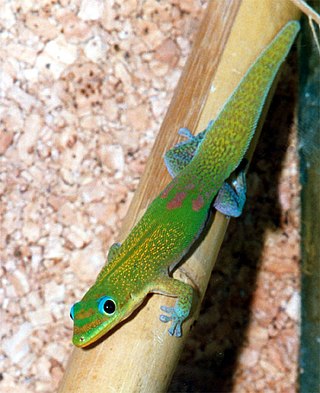
Geckos are small, mostly carnivorous lizards that have a wide distribution, found on every continent except Antarctica. Belonging to the infraorder Gekkota, geckos are found in warm climates throughout the world. They range from 1.6 to 60 centimetres.
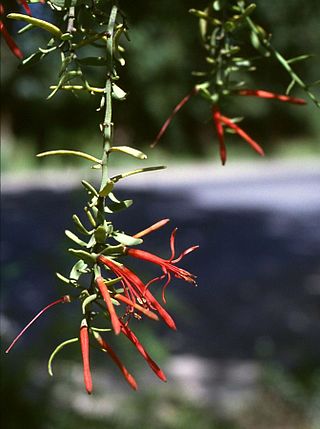
Loranthaceae, commonly known as the showy mistletoes, is a family of flowering plants. It consists of about 75 genera and 1,000 species of woody plants, many of them hemiparasites. The three terrestrial species are Nuytsia floribunda, Atkinsonia ligustrina, and Gaiadendron punctatum Loranthaceae are primarily xylem parasites, but their haustoria may sometimes tap the phloem, while Tristerix aphyllus is almost holoparasitic. For a more complete description of the Australian Loranthaceae, see Flora of Australia onlineArchived 2018-04-01 at the Wayback Machine., for the Malesian Loranthaceae see Flora of Malesia.

Vegetation is an assemblage of plant species and the ground cover they provide. It is a general term, without specific reference to particular taxa, life forms, structure, spatial extent, or any other specific botanical or geographic characteristics. It is broader than the term flora which refers to species composition. Perhaps the closest synonym is plant community, but vegetation can, and often does, refer to a wider range of spatial scales than that term does, including scales as large as the global. Primeval redwood forests, coastal mangrove stands, sphagnum bogs, desert soil crusts, roadside weed patches, wheat fields, cultivated gardens and lawns; all are encompassed by the term vegetation.
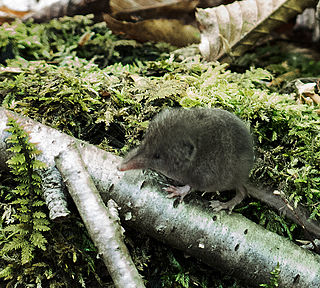
The North American least shrew is one of the smallest mammals, growing to be only up to 3 inches long. It has a long pointed snout and a tail never more than twice the length of its hind foot. The dense fur coat is either grayish-brown or reddish-brown with a white belly. Its fur becomes lighter in the summer and darker in the winter. Although similar in appearance to several species of rodents, all shrews are members of the order Eulipotyphla and should not be mistaken for a member of the order Rodentia. The North American least shrew's eyes are small and its ears are completely concealed within its short fur, giving it very poor eyesight and hearing.

The genus Cryptotis is a group of relatively small shrews with short ears, which are usually not visible, and short tails, commonly called small-eared shrews. They have 30 teeth and are members of the red-toothed shrew subfamily. Since 1992, Neal Woodman at the United States National Museum has been in the process of revising the genus. To date, this has resulted in an increase in the number of species from 12 to 30.
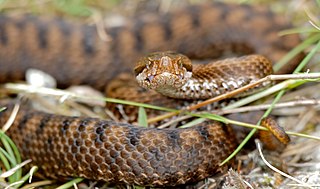
Vipera aspis is a viper species found in southwestern Europe. Its common names include asp, asp viper, European asp, and aspic viper, among others. Like all other vipers, it is venomous. Bites from this species can be more severe than from the European adder, V. berus; not only can they be very painful, but approximately 4% of all untreated bites are fatal. The specific epithet, aspis, is a Greek word that means "viper." Five subspecies are currently recognized, including the nominate subspecies described here.

Atolla wyvillei, also known as the Atolla jellyfish, Coronate medusa, and deep-sea jellyfish, is a species of deep-sea crown jellyfish. It lives in oceans around the world. Like many species of mid-water animals, it is deep red in color. This species was named in honor of Sir Charles Wyville Thomson, chief scientist on the Challenger expedition.

Atolla is a genus of crown jellyfish in the order Coronatae. The genus Atolla was originally proposed by Haeckel in 1880 and elevated to the monotypic family level, as Atollidae by Henry Bigelow in 1913. The six known species inhabit the mesopelagic zone. The medusae possess multiple lobes called lappets at the bell margin. Medusae also have eight tentacles, alternating with eight rhopalia, and twice as many lappets occur as tentacles.
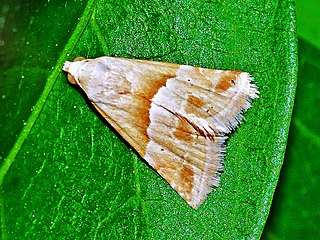
Eublemma parva, the small marbled, is a moth of the family Erebidae. The species was first described by Jacob Hübner in 1808.
Emmonsia parva is a filamentous, saprotrophic fungus and one of three species within the genus Emmonsia. The fungus is most known for its causal association with the lung disease, adiaspiromycosis which occurs most commonly in small mammals but is also seen in humans. The disease was first described from rodents in Arizona, and the first human case was reported in France in 1964. Since then, the disease has been reported from Honduras, Brazil, the Czech Republic, Russia, the United States of America and Guatemala. Infections in general are quite rare, especially in humans.

The 20th Century Press Archives comprises about 19 million newspaper clippings, organized in folders about persons, companies, wares, events and topics.

Laternula is a genus of bivalves belonging to the family Laternulidae.

Atolla tenella is a species of jellyfish in the family Atollidae which lives in the Arctic Ocean. Its main characteristic is the long trailing tentacle that is way longer than the others.
Atolla reynoldsi is a species of true jellyfish in the family Atollidae. It is known from type specimens found in the north Pacific Ocean.
Atolla vanhoeffeni is a species of true jellyfish in the family Atollidae.

Atolla gigantea is a species of true jellyfish in the family Atollidae. It is known from type specimens found in the north Pacific Ocean.

Atolla valdiviae is a species of true jellyfish in the family Atollidae. It is known from type specimens found in the north Pacific Ocean.
Atolla russelli is a species of true jellyfish in the family Atollidae. It is known from type specimens found in the north Pacific Ocean.
Atolla verrillii is a species of true jellyfish in the family Atollidae. It is known from type specimens found in the north Pacific Ocean.

Atolla bairdii is a species of true jellyfish in the family Atollidae. It is known from type specimens found in the north Pacific Ocean.












